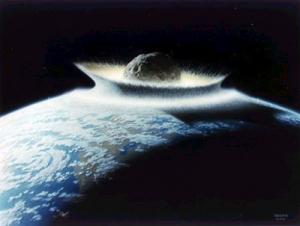The recent images from Cassini’s flyby of Mimas remind us how violent the history of the early Solar System was. Now a study at the Australian National University shows that three huge asteroids — between 20 and 50 kilometers across and traveling as a cluster — collided with the Earth some 3.2 billion years ago. The result: volcanic eruptions, the creation of major fault lines, earthquakes and a variety of disruptive effects deep inside Earth’s crust.
 This work grows out of evidence of extraterrestrial impact deposits from this era discovered in South Africa and extends the effects of those impacts to the Pilbara region of Western Australia. According to an ANU news release, the materials studied in the eastern Transvaal had indicated that impact craters several hundreds of kilometers in diameter had been created in oceanic parts of the Earth. In the Australian studies, the impacts coincide with the formation of fault escarpments and fault troughs and a major volcanic episode.
This work grows out of evidence of extraterrestrial impact deposits from this era discovered in South Africa and extends the effects of those impacts to the Pilbara region of Western Australia. According to an ANU news release, the materials studied in the eastern Transvaal had indicated that impact craters several hundreds of kilometers in diameter had been created in oceanic parts of the Earth. In the Australian studies, the impacts coincide with the formation of fault escarpments and fault troughs and a major volcanic episode.
Image: Artist’s concept of a catastrophic asteroid impact with the Earth. Life near the impact would be instantly wiped out from the effects of high temperatures and pressures. Injection of huge masses of dust (and gases) into the atmosphere would effectively block out sunlight for long periods of time to the point that most life could not be sustained (“Nuclear Winter”). Credit: Don Davis/NASA.
“The precise coincidence of the faulting and igneous activity with the impact deposits, coupled with the sharp break between basaltic crust and continental formations, throws a new light on the role of asteroid impacts in terrestrial evolution,” Dr. Andrew Glikson said. Glickson has been working on these studies with John Vickers from the Department of Earth and Marine Sciences at ANU.
Centauri Dreams‘ note: Another result of this investigation is the indication that the Moon was affected at roughly the same time by major asteroid impacts and resurgent vulcanism. Any way you look at it, a forming planetary system seems to be a place of chaos, as witness the growing evidence that our Moon was caused by a collision between the Earth and a body perhaps the size of Mars. We should expect the same situation to be occurring in young extrasolar planetary systems. Possible corroboration is found in the intense dust cloud around the Sun-like star BD +20 307 in Aries (discussed earlier in Centauri Dreams), where major collisions between planetoids seem to have occurred.

